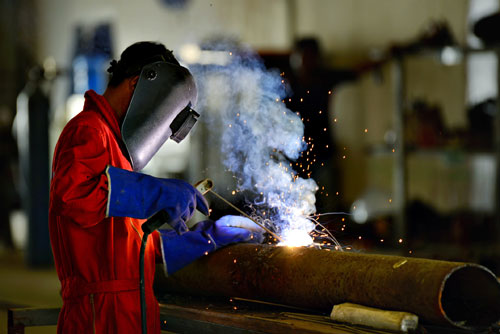Structural Iron and Steel Worker Careers
 Structural iron and steel workers install structural and reinforcing steel and iron that serve as the main support of bridges, roads and buildings. If you select this career, you may be required to look at blueprints or sketches and follow other instructions. You may need to use equipment to unload or load iron and steel as well as help crane operators who will use equipment to move and place the iron and steel.
Structural iron and steel workers install structural and reinforcing steel and iron that serve as the main support of bridges, roads and buildings. If you select this career, you may be required to look at blueprints or sketches and follow other instructions. You may need to use equipment to unload or load iron and steel as well as help crane operators who will use equipment to move and place the iron and steel.
Iron and steel workers will learn to use shears and rod-bending machines to bend, cut, and weld the iron and steel. You may be taught how to use plumb bobs, lasers, tag lines and levels to align steel horizontally and vertically.
Structural Iron and Steel Worker Career Snapshot
Nearly all iron and steel workers work in construction-related businesses. Many work for contractors who lay foundations or build structures for their clients. Others work in non-residential building construction.
Iron and steel workers have to work outside in difficult weather and often high up from the ground. As a result, they perform dangerous work that can be physically demanding. If you choose this career path, you must wear safety devices like harnesses to protect yourself from the chance of falling. Iron and steel workers suffer a higher number of work-related injuries and deaths each year.
Further details on a career as a structural iron and steel worker are listed below (statistics from the May 2015 Bureau of Labor Statistics and Onet Online):
is the estimated yearly salary for structural iron and steel workers.
increase in employment between 2014 and 2024.
have an High school diploma or equivalent while 34% have less than a High school diploma.
Structural Iron/Steel Worker Education
Nearly half of all structure iron and steel workers have earned a high school diploma but about a third have not completed high school.
Structural Iron/Steel Worker Job Duties
Structural iron and steel workers spend their days building new structures such as buildings, bridges or roads, but they also help demolish and rehabilitate older buildings and bridges. You may work with reinforcing steel like rebar to strengthen the materials that are used in building highways and buildings. You may also work with special cables or welded wire to reinforce structures as well. In some cases, iron or steel workers may help assemble and fabricate in shops.
Structural Iron/Steel Worker Salaries
The average salary for iron and steel workers is about $50,490 per year with starting salaries in the range of $29,770, and top earners making $90,490 annually (2015 BLS.gov).
Structural Iron/Steel Worker Job Outlook
The employment of iron and steel workers is expected to grow 4 percent from 2014 to 2024. Specific categories within this area vary greatly but are generally expected to increase across the board. Many older highways and bridges need to be maintained, rehabilitated or replaced into the future, which will help drive the growth.
Structural Iron and Steel Worker Skills & Traits
| Structural Iron & Steel Worker Skill Set: | Required Abilities: | Tools Used by Structural Iron & Steel Workers: | Typical Work Activities: |
|---|---|---|---|
| • Coordination • Operation and Control • Operation Monitoring • Active Listening • Critical Thinking | • Multilimb Coordination • Static Strength • Arm-Hand Steadiness • Manual Dexterity • Near Vision | • Blow torch • Laser levels • Manlift or personnel lift • Mill saw file • Power riveter | • Multilimb Coordination • Static Strength • Arm-Hand Steadiness • Manual Dexterity • Near Vision |
Related Careers
Boilermakers
High School Diploma or Equivalent
Carpenters
High School Diploma or Equivalent
Construction Laborers
High School Diploma or Equivalent


